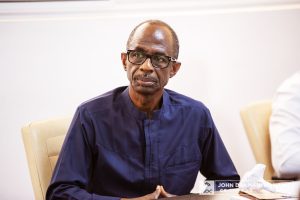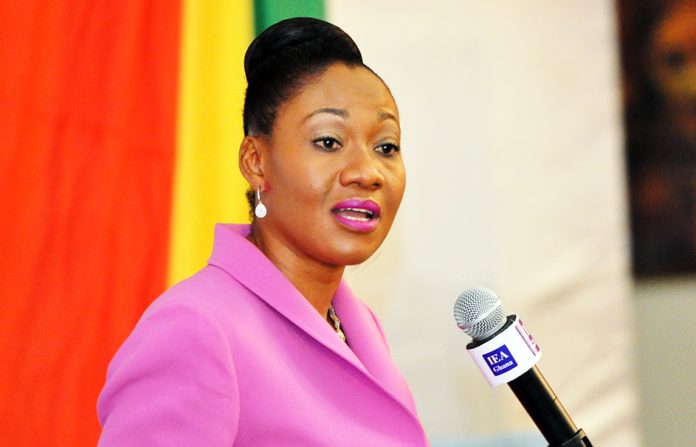The proponents of the forensic audit of the voter register for the 2024 general elections, the National Democratic Congress (NDC), have failed to provide the Electoral Commission with evidence to investigate their grievances, the Commission has said.

Addressing the Inter-Party Advisory Committee (IPAC) meeting on Tuesday, October 1, 2024 the EC indicated that the NDC, during a meeting spelt out the issues, but it requested for evidence from the NDC to be able to address the issues, but same were not forthcoming.
“The NDC presented five categories of issues with the register. The commission demanded of the NDC to present further evidence… Unfortunately, the NDC has still not presented any more evidence to the EC,” Jean Mensa said in her address at IPAC on Tuesday.
She continued that, “it is for these reasons that this IPAC meeting has been organised to enable all parties to present any evidence on discrepancies in the voters register, but it must be noted that the current register is not perfect and not final,” she stated.
ISSUES ADDRESSED
Though the EC chair mentioned that the NDC did not provide any evidence to aid the probe into the issues they had complained about, the Commission nonetheless went ahead to address the five issues one after the other in a PowerPoint presentation at the IPAC meeting.
The Head of IT at the EC, Dr. Yaw Ofori Adjei, in an in-depth PowerPoint presentation indicated that it was important the EC addressed the issues, “even though we knew that most of the issues that had been raised are issues that have already been dealt with.”
The Commission said it met with the NDC on September 6, 2024 during which the issues, which the NDC termed as observations, were raised and the request for evidence was also made.
OBSERVATION ONE
The first observation made by the NDC was that the EC had deleted 3,957 voter names from the voters register. The NDC blamed this deletion on transfers.
Responding to the observation, Dr. Yaw Ofori Adjei said in the minds of the EC, they could not see “how you can delete somebody’s name by transferring them, because transfers are allowed. So you can’t delete somebody by transferring them.”
He continued that per the design of the voter management system once you get registered onto the system you cannot be deleted.
He explained that an individual could only be eternally on one of three lists; the valid voter lists, the exceptions list and the multiples list.
He further stated that the EC keep a record of every transfer that is done and the record is very detailed all the way down to the center that transfer was done.

“Who is involved, where you were transferred to, which people approved the transfer. So, that record is there no matter where you go. If we want to trace where you have been we know exactly where you have been and who initiated that transfer.
“So if you look at the first allegation of the alleged deletion of voters from the 2024 register, as I have said nobody gets deleted from the register. Once you are on the register you’re on those three lists and we’ve already said that transfers are legitimate and permissible by law,” he narrated.
He said that the reference case that the NDC gave and attributed to a deletion is not factual, intimating that the said person “is actually on the register and has been transferred to a new polling station D040204,” in the Volta region whose transfer occurred on June 14, 2024.
OBSERVATION TWO
The second observation the NDC made was that 2,094 voters were transferred to different police stations, but do not exist on the absent voter list.
The EC, in response, said that it has looked at the absent voter list that was submitted to the political parties and to the polling stations.
“And we can confirm that the absent voter list for that particular police station was empty. And it was a correct observation. They had correctly picked up that there was an error,” the EC said.
He, however, added that the EC themselves had “already picked up that error and a new list had been generated and sent to the various polling stations that were affected. Once again, remember that it is a process.
“We have several systems querying the same databases. Sometimes errors occur in transit. But it’s a human institution and errors occur.”
He confidently told the stakeholders at the IPAC meeting that the Commission had regenerated those registers and sent them back earlier on in the registration process.
“What you are seeing now is our register viewer, which gives us a panoramic view of everybody that is in the register,” he showed on a screen during the PowerPoint presentation.
“So we zoom down to this particular polling station, and the individual that’s being referenced here now, as you can see, together with all the other people who should be on the absent voter list are there.
“And this is evidence that the issues that were raised, notwithstanding the NDC reporting it, are those that we detected ourselves have been fixed. And if you look at the current register assistance now, we see that a lot of the issues have been fixed,” the EC IT head said in his presentation.
While emphasising that the Commission was addressing the NDC issues notwithstanding, the party’s failure to provide evidence, Dr. Ofori Adjei said that it is an evolving process that will culminate into a final voter’s register.
“And therefore, we should allow the processes to work.
Observation three; we see that previously transferred illegally to previous transfers were illegally added to the 2024 transfers,” he added.
He reiterated that the commission has already admitted to the fact that the transfer voter register that it is giving contained much more than the numbers that were expected for the 2024 registration period.
“So you had much more. And if you take a critical look at the transfer registers, you see certain narratives like reversal of special transfers, because they are all considered one transfer or the other, but there are different categories of them. In generating them, all the transfers were added, including those from 2020.
“So you had 2020 transfers, you had 2023 transfers, you had 2024 transfers that were added, including even special voting was also added to it. This, as was said by Dr. Bossman, had been detected, and the error had been corrected. So, the new voter register that you are going to get will contain only transfers those that were done for the 2024 season,” he explained.
He said that, be that as it may, because of the uproar that was associated with it, the commission went a step further to undertake deeper auditing of the transfer register.
According to him, the Commission asked for all the paper records of transfers that were done to be reconciled against what was in the district viewer. The move was for them to be sure that if you did a transfer, you are in there.
He admitted that the EC did encounter some problems, as sometimes the transfers were not complete because of the network errors that it encountered. However, those ones were corrected during the exhibition period.
“So it was a good exercise that was taken to ensure that those who had transferred their votes indeed will be where they are supposed to be on Election Day.
“Having also said that, we’ve also ensured that all the transfers that were done are legitimate and they are accurate,” Dr. Adjei said.
Having offered that explanation, he said that “the absent voters list and the transfer voters list for the 2024 period will only contain those that were done for the 2024 period.”
OBSERVATION THREE
The third issue the NDC raised was about some transfers in Pusiga. The Commission said it listened to the news and was aware that there were issues with the transfers that were carried at Pusiga.
The EC said its regional director reported that 38 voters had been illegally transferred from Pusiga. The Commission admitted that its own staff took advantage of a vulnerability that was in the system, stating “that vulnerability was the sense of a liveliness check.”
Some people “used the picture on the voter ID card to verify the individuals and do a transfer. Be that as it may, because our systems works, we were able to verify that indeed, spoofing had occurred.
“And we’ve been able to pick up and confirm that indeed, all the 38 people that were involved, whose transfers were done, were done through this method.”
Reporting on what the Electoral Commission had done following the discovery, the Head of IT said the first step was to block that vulnerability.
He added that the technology has now matured such that it can be deployed into production use, indicating further that now the EC has made sure that facial verification now has a liveliness check put in place.
ACTION TAKEN
“We didn’t stop there. We’ve also now implemented the liveliness check on our voter verification devices, our biometric verification devices. So on voting day, you can’t take somebody’s picture, use the BVD (Biometric Verification Device) to do verification, because now that is firmly built into the BVD as well.
“So we have plugged that hole. Subsequent to that, all those transfers that have been done have been reversed. So all those transfers that were done illegally have been reversed,” he noted.
Meanwhile, the perpetrators, Dr. Ofori Adjei noted, have been dismissed by the commission, and the police is carrying out their investigation into the matter.
“We have not taken this matter lightly. And so we have not taken this matter lightly at all,” he stressed.
ASSURANCE
The Head of IT was frank that since it happened in Pusiga, chances were that it occurred elsewhre. However, he allayed the fears of stakeholders that the Commission was developing tools to deal with the issue.
Noting that there was no system in the world that is foolproof, he assured the stakeholders that the Commission was working to make its systems better.
“We are developing tools, once again, that will go through the system thoroughly to check and be sure that the same nefarious act has not been committed again. And by the end of the week that report would be ready. But rest assured the commission is not taking this lightly at all. And we are making sure that we are making the systems better. There is no system in this world that is foolproof,” he remarked.
He continued that, “We are constantly evolving. And we are hypercritical of ourselves. So we are looking at ways of improving the systems that we have built, both with our service providers and our software vendors. So rest assured, this issue is being given the best attention that it can get.”
OBSERVATION FOUR
The fourth observation from the NDC said that there were about 15,000 unidentified transfer paths.
This issue the EC said it was not clear what the NDC meant by an unidentified transfer path, arguing that all the transfers are documented.
Dr. Adjei said it was not the commission’s business to understand why somebody wants to transfer their vote for so long as they are doing it in the proper way.
“So we do not understand what by unidentified transfer path. But be it as it may, we went ahead and looked at the samples that they had given us. So in their presentation, there were four ID cards that were listed as people who did transfers and there was no clear identified path for the transfer. We looked at them.
“And we can confirm that these ID cards, these ID numbers, that they said there was no clear identified path, have all done registrations or transfers at the time that we have listed there and from one polling station to the other. So these were legitimate transfers that were done. So we do not really understand what they mean by you can’t identify the pathway of the transfer,” the EC said.
DEMONSTRATION
In his presentation, Dr. Ofori Adjei reference one of the persons identified to illustrate the point the transfer paths could be identified.
“So I will take one of them as a reference and show to you that indeed, if we want to identify the pathway that they undertook to get to where they are now, we can. So this is for voter with voter ID 4728026669 (he demonstrated on the screen for everyone to see). You bear with me that this is the picture.
“This is one of the pictures that have been listed as having an unidentified pathway. Now, as I’ve said, we record every transfer. Every transfer that is done is recorded, and is recorded on two systems. It is recorded on automatic biometric identification system and it’s recorded on the voter management system. So we have two records to compare at any point in time to confirm that a transfer was actually done.
“If it is a picture that you are using for the transfer, a picture that was taken at the time that the transfer was done to confirm, and that is what is used to do the one to one matching. So if you look, this is the picture of the voter on the card. Same picture here. And this is the picture that we have on record. Down here, you have the fingerprints of the individual.
“If the individual has used their fingerprints for verification, here, you will have the verification listed here, together with the score, the head score to show that it is indeed the person. And here is the picture of the individual that did the transfer. So this transfer was not done in a vacuum.
“It was done by an evidence to show that indeed she presented herself to do that transfer. So the path is there. So we do not understand what is meant by there is no clear or there are unidentified paths towards a transfer.”
He continued that, “To give you further evidence, this is a transaction from our automated biometric identification system that gives you the details of everything that was done right down to the second that the verification for transfer was executed. And once again, this data is available for verification. And I assure you, all the 330,000 something who did transfers we have all their records available in our system for verification.
“Now, we go to the hard copy itself. And for this, I put two of them here. So this is the individual. And this shows them. This is their voter ID card. This is where they are. This is the actual hard paper form that’s been completed for the transfer together with their thumbprints and their signature together with the officer who did the transfer. So, there’s nothing like unidentified transfer path. We know who you are, where you are, how you did the transfer and where you are now.”
“And we have both paper evidence and electronic evidence to support it. So it cannot be said that there’s no identified pathway for the transfer. And so we’ve got 15,000 plus people who are affected. This is another individual from the previous pictures that I’ve shown to you. And this is the evidence that shows that that individual actually did the transfer.”
OBSERVATION FIVE
“We move on to observation five. And observation five says that there were 168 corrupt files. That’s indeed true. It did happen. There were some of the files that were given in the provisional voter’s register that were not 1,685 corrupt files. And I’m saying that that observation indeed is accurate. We did have some correct files. As to whether it was 168, we are not sure. But we did have some corrupt files. And as I said, once again, these corrupt files came as a result of network interruptions that occurred during the production of those registers.”
“These, as I’ve said, were promptly picked up by the commission staff. Because remember that at level one, which is the hard inspection of the registers, hand, page by page, these things were detected and were reported to the commission. And immediately, new ones were generated and sent back to the political parties. As I’ve said, we know for sure that there are electronic systems we are working with. They are not foolproof. Sometimes errors happen.
“So we’ve made it sure that on election day, this will not happen. What have we done? We have now generated additional tools that check all the outputs that come out of the register to ensure that they contain contents. And we are doing it at three different levels.
“At generation, and then we have two independent systems that are checking the registers as they are produced to be sure that they contain data. Anyone that doesn’t contain data is immediately flagged and will be regenerated.
Having said that, we also have the manual process of checking, that will happen both at the commission before it goes to the printers and as the printers themselves, as they are being printed, to ensure that we don’t have these issues coming up.
“And so rest assured, come December 7th, the registers that will be sent to the polling stations will not have these issues,” the EC said at the IPAC meeting, which the NDC attended.
After the presentation, several political parties, including the New Patriotic Party, the Liberal Party of Ghana, expressed confidence in the electoral commission.
The NPP, in particular, said the claims of its main opponent, the NDC, were baseless, and reminded the NDC of its posture in 2015 when issues about the register were raised.









